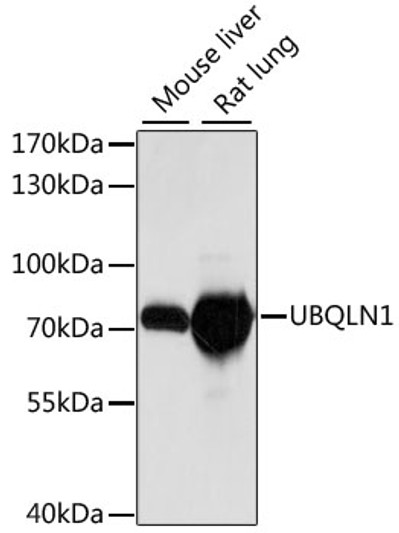| Tissue Specificity | Brain (at protein level). Ubiquitous. Highly expressed throughout the brain.detected in neurons and in neuropathological lesions, such as neurofibrillary tangles and Lewy bodies. Highly expressed in heart, placenta, pancreas, lung, liver, skeletal muscle and kidney. |
| Post Translational Modifications | Degraded during both macroautophagy and during chaperone-mediated autophagy (CMA). Phosphorylated. Ubiquitinated. |
| Function | Plays an important role in the regulation of different protein degradation mechanisms and pathways including ubiquitin-proteasome system (UPS), autophagy and endoplasmic reticulum-associated protein degradation (ERAD) pathway. Mediates the proteasomal targeting of misfolded or accumulated proteins for degradation by binding (via UBA domain) to their polyubiquitin chains and by interacting (via ubiquitin-like domain) with the subunits of the proteasome. Plays a role in the ERAD pathway via its interaction with ER-localized proteins UBXN4, VCP and HERPUD1 and may form a link between the polyubiquitinated ERAD substrates and the proteasome. Involved in the regulation of macroautophagy and autophagosome formation.required for maturation of autophagy-related protein LC3 from the cytosolic form LC3-I to the membrane-bound form LC3-II and may assist in the maturation of autophagosomes to autolysosomes by mediating autophagosome-lysosome fusion. Negatively regulates the TICAM1/TRIF-dependent toll-like receptor signaling pathway by decreasing the abundance of TICAM1 via the autophagic pathway. Promotes the ubiquitination and lysosomal degradation of ORAI1, consequently down-regulating the ORAI1-mediated Ca2+ mobilization. Suppresses the maturation and proteasomal degradation of amyloid beta A4 protein (A4) by stimulating the lysine 63 (K63)-linked polyubiquitination. Delays the maturation of A4 by sequestering it in the Golgi apparatus and preventing its transport to the cell surface for subsequent processing. Ubiquitinates BCL2L10 and thereby stabilizes protein abundance. Isoform 1: Plays a role in unfolded protein response (UPR) by attenuating the induction of UPR-inducible genes, DDTI3/CHOP, HSPA5 and PDIA2 during ER stress. Plays a key role in the regulation of the levels of PSEN1 by targeting its accumulation to aggresomes which may then be removed from cells by autophagocytosis. Isoform 2: Plays a role in unfolded protein response (UPR) by attenuating the induction of UPR-inducible genes, DDTI3/CHOP, HSPA5 and PDIA2 during ER stress. Isoform 3: Plays a role in unfolded protein response (UPR) by attenuating the induction of UPR-inducible genes, DDTI3/CHOP, HSPA5 and PDIA2 during ER stress. Plays a key role in the regulation of the levels of PSEN1 by targeting its accumulation to aggresomes which may then be removed from cells by autophagocytosis. |
| Protein Name | Ubiquilin-1Protein Linking Iap With Cytoskeleton 1Plic-1Hplic-1 |
| Database Links | Reactome: R-HSA-8856825 |
| Cellular Localisation | CytoplasmNucleusEndoplasmic ReticulumCytoplasmic VesicleAutophagosomeCell MembraneDetected In Neuronal Processes And At SynapsesRecruited To The Er During Er-Associated Protein Degradation (Erad)Isoform 1 And Isoform 3 Colocalize With Psen1 In The Cell Membrane And In Cytoplasmic Juxtanuclear Structures Called AggresomesColocalizes With Orai1 And Ticam1 In The AutophagosomeColocalizes With Eps15 And Hgs In Ubiquitin-Rich Cytoplasmic Aggregates That Are Not Endocytic Compartments And With Eps15 Also In Aggresomes |
| Alternative Antibody Names | Anti-Ubiquilin-1 antibodyAnti-Protein Linking Iap With Cytoskeleton 1 antibodyAnti-Plic-1 antibodyAnti-Hplic-1 antibodyAnti-UBQLN1 antibodyAnti-DA41 antibodyAnti-PLIC1 antibody |
Information sourced from Uniprot.org








